Importance of Aging Nutrition
Introduction to Nutrition Requirement for Elderly Population
With the introduction of advanced medicines and therapy, there is a shift in the life expectancy of the global population. The average global population is getting older, with more than one in every five people aged 60 or above by 2050.
Nutrition plays an essential role in the growth, development, and immunity throughout the lifespan of an individual. The establishment and development of the immune system depend on providing critical nutrition to infants and toddlers. At the same time, healthy aging essentially helps in maintaining a balanced diet to retain the correct functioning of the immune system. As a result, growing life expectancy has opened opportunity segments to meet the nutritional requirements for the aging population.
Common factors that impacting nutrition intake for the elderly population, depicted in Exhibit 1, include a poor diet, need for special nutritional foods, financial issues, etc., which results in malnutrition issues among more than 40% of the senior populations.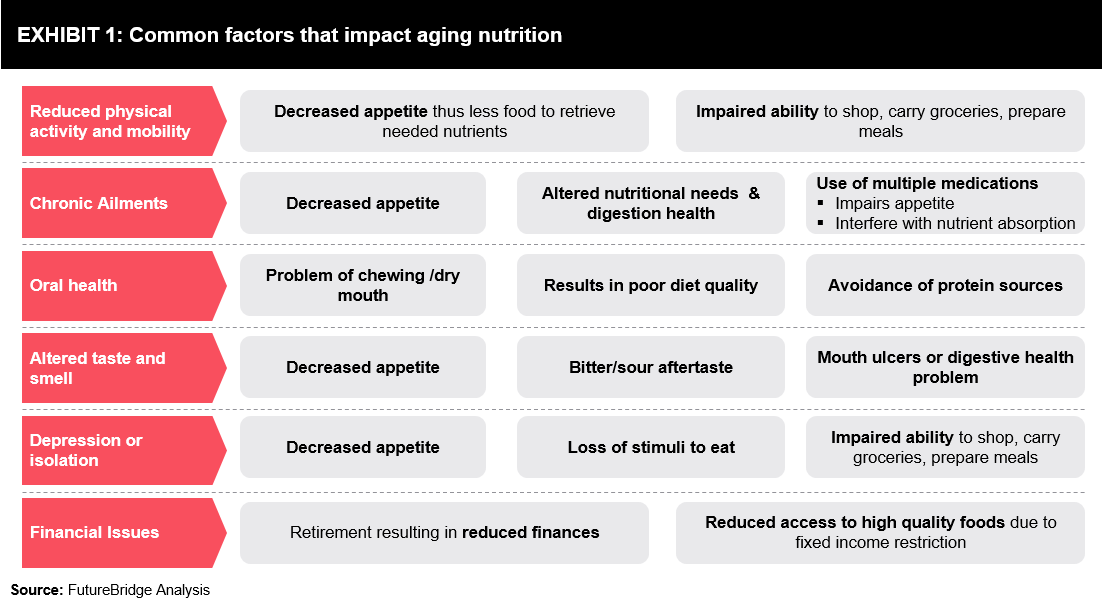
Special foods and diets designed for the aging population
Aging and elderly population are vulnerable to age-associated, infectious, and chronic illness, and so, primary and secondary strategies to reduce the risk of contracting any disease is essential. Nutrition plays one of the crucial roles in reducing the risk of illness and improving their quality of life. Hence, emphasizing the consumption of specific nutrients, foods, and implementing a particular diet pattern promotes “healthy aging” and has a positive health impact.
It helps in preventing chronic ailments and age-related complications such as osteoporosis, high blood pressure, heart diseases, active immune system, etc.
As shown in Exhibit 2, the intake of proteins, vitamins, calcium, potassium, magnesium, zinc, and dietary fibers are essential for the aging population with enlisted benefits of consumption and deficiency-related risks.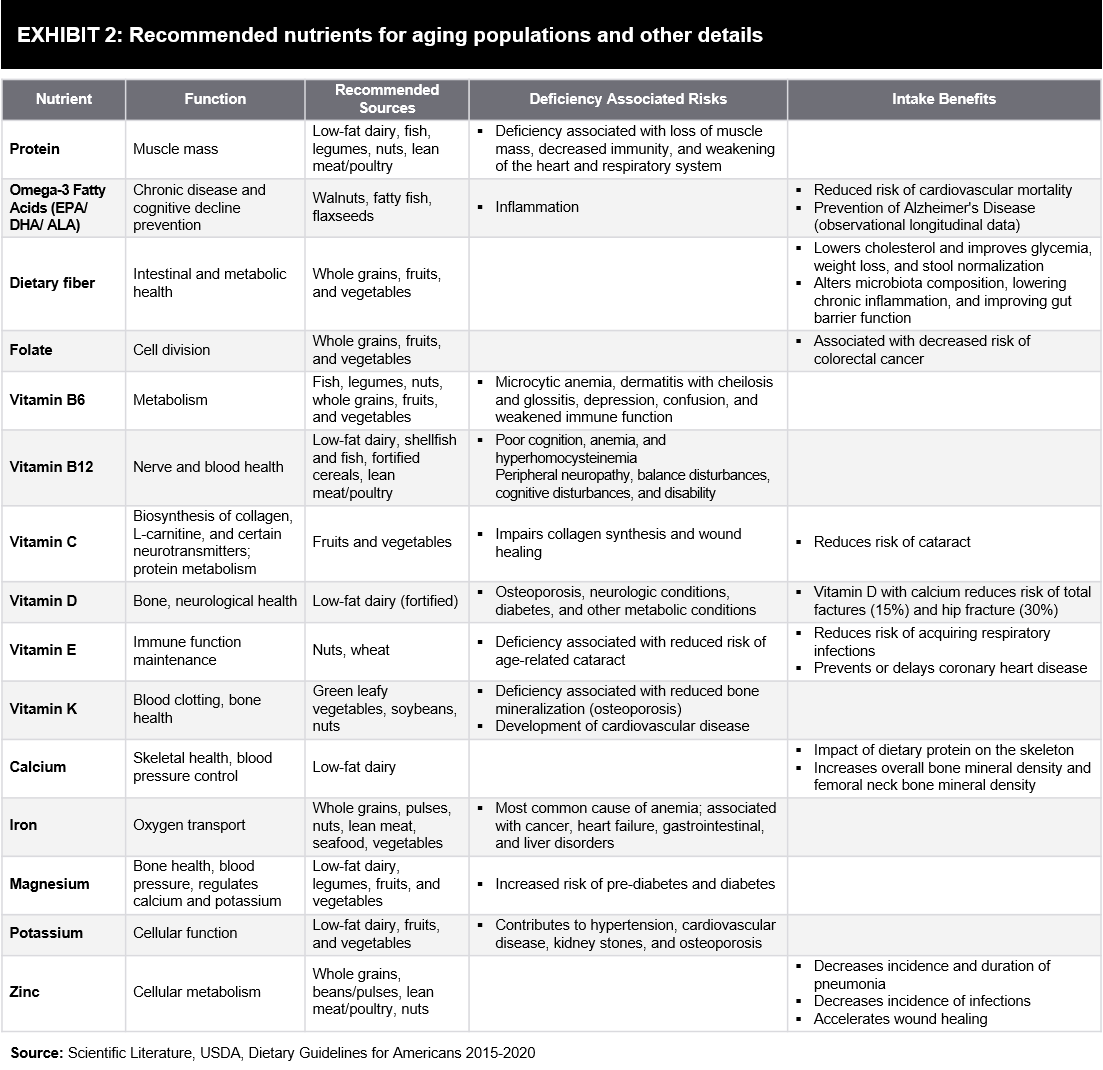
Impact of Current Pandemic on Elderly Population
Introduction to COVID-19, condition caused by a novel coronavirus
The wake of 2020 has seen an outbreak of a viral flu-like infection caused by a novel coronavirus, which spread rapidly from China’s Wuhan to 199 countries across the world (as of Mar 30th, 2020). With the sudden outbreak and rapid spread globally, on Mar 11th, 2020, the World Health Organization (WHO) global pandemic.
Illustrated in Exhibit 3, as of Mar 30th, 2020, more than 735 thousand population is affected by the novel coronavirus.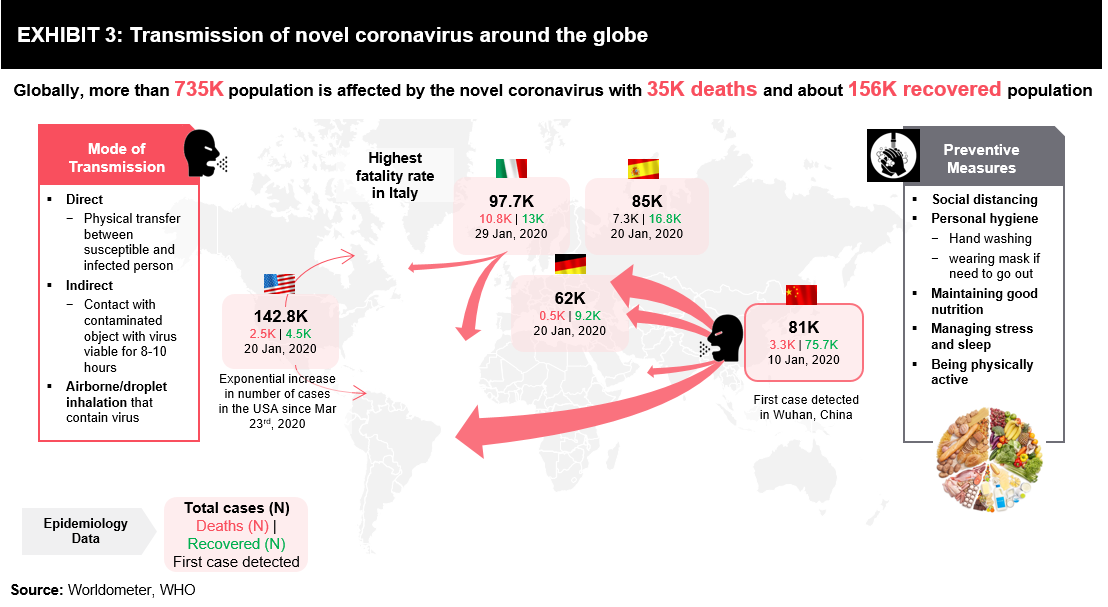
Transmission & clinical pathogenesis of novel coronavirus
The novel virus spreads through direct contact via infected patients or aerosols/droplets released during sneezing/coughing. Data indicates that the older segment with pre-existing conditions like cancer, diabetes, high blood pressure, and lung diseases are high-risk populations who can contract the infection and may need medical care.
Novel coronavirus results in flu-like symptoms termed as COVID-19, which is accompanied by breathing difficulties and dry cough. COVID-19 is marked with severe lung inflammation resulting in congestion and fibrosis, which triggered due to cytokine storm in the lungs. The cytokine storm is an immune response to foreign bodies (viruses) that enter the lungs, which helps in fighting against the viruses. However, among a few, the cytokine storm is not correctly regulated and destroying lung cells (aioli) along with the infection that can also result in secondary bacterial infection resulting in the patient’s death.
Fatality Rate of COVID-19
According to the real-time epidemiology assessment, the elderly and the immunocompromised demographics are most affected by the virus, and the fatality rate of COVID-19 is highest among the progressive age groups due to their reduced immunity.
As illustrated in Exhibit 3, the fatality rate of COVID-19 among children (0-9 years) is 0% while that among the 80+ years is 22% confirmed cases, and a few are suspected accounting it to about 14.8%.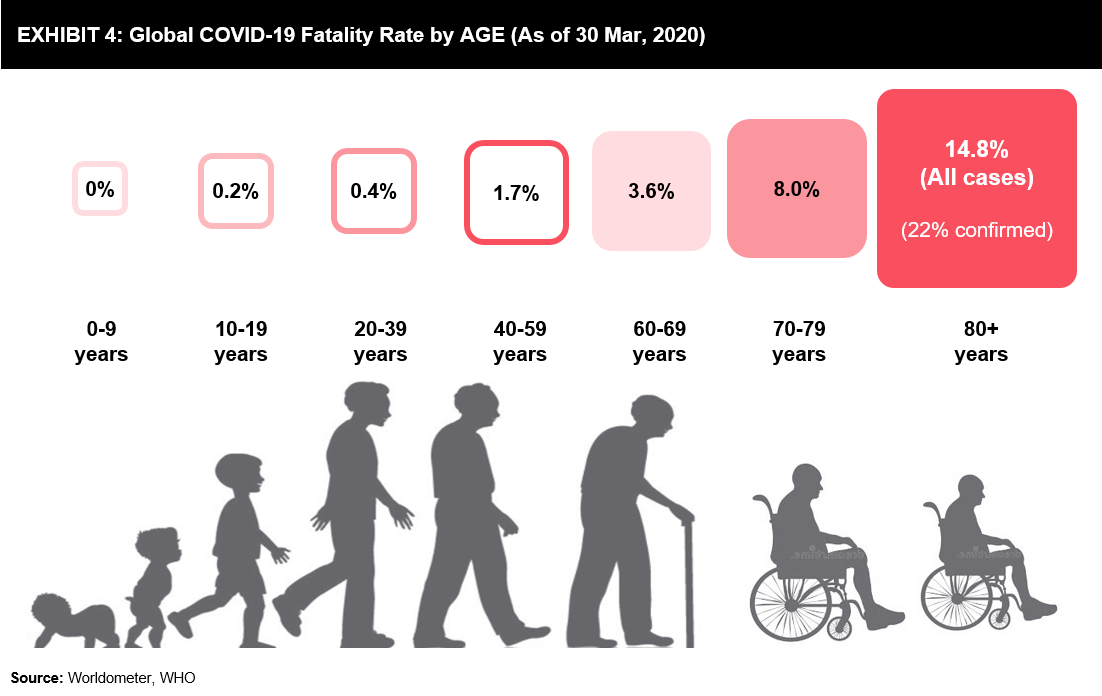
Global impact on due to COVID-19
COVID-19 pandemic has resulted in a lockdown or quarantine of more than a third of the worldwide population. This lockdown has been imposed to control the transmission of the virus and prevent the higher risk segment – elderly and immunocompromised population from contracting the infection, which can be fatal for them.
The lockdown is majorly on traveling – international and local to reduce the direct transmission of the virus. Food and dairy industries are operational in a majority of the countries to meet the nutritional demand in the markets.
Rules to prevent transmission to the vulnerable population
Amidst the pandemic following are the standard rules to prevent infection among the aging population are:
- Social distancing
- Personal hygiene – handwashing, wearing a mask if need to go out
- Maintaining good nutrition
- Managing stress and sleep
- Being physically active
Nutritional Recommendations
Functional products targeted towards the elderly segment
Balanced and optimized nutrition for aging and the elderly is essential. Food and beverage manufacturers have started to identify this opportunity segment and invested in the development and introduction of functional foods and supplements catering to the older population. Exhibit 5 depicts examples of products for the elderly segment.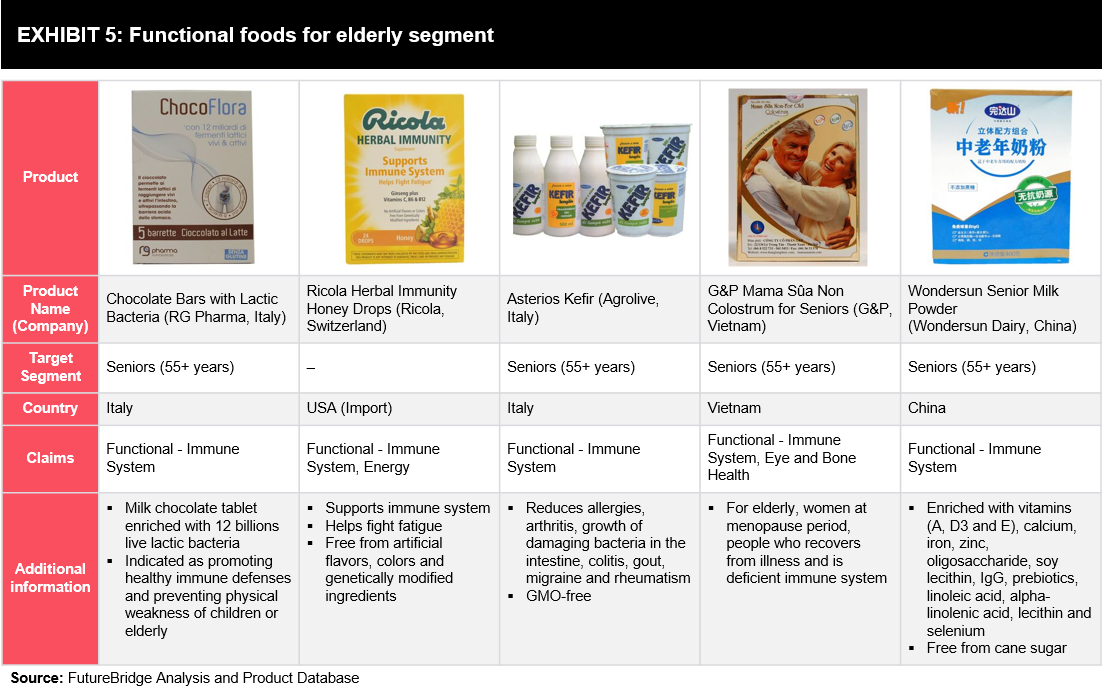
Functional ingredients that help boost the immune system
Functional ingredients that are explored currently for healthy aging include – Astaxanthin, Berries, and Grape seed extracts, depicted in Exhibit 6.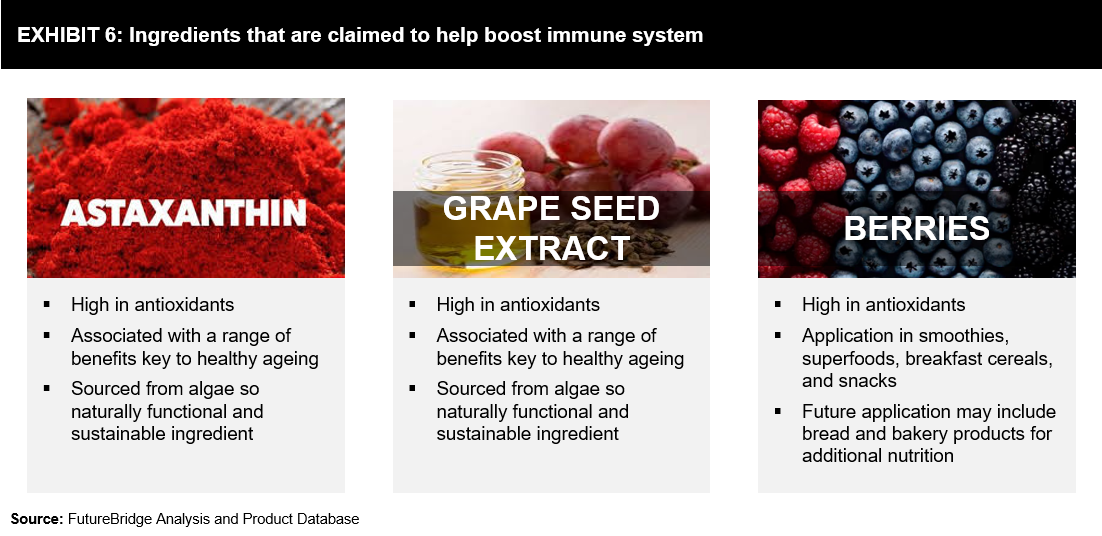
It is essential to focus on a healthy diet to maintain proper nutrition accompanied with immune-boosting nutrients that include calcium, vitamins, minerals, antioxidants, dietary fibers, and so on. Asthaxanthin and grape seed extract are currently being explored for application in different food products. Superfoods like berries, whole grains, and so on also provide functional health benefits such as anti-oxidation, fiber content, etc.
For healthy aging, it is essential to consume a balanced and nutritious diet. Further, in the wake of an epidemic or pandemic, maintaining personal hygiene and proper nutrition are two pillars to prevent from contracting the infection.
References
- Scientific Literature
- USDA
- Dietary Guidelines for Americans 2015-2020
- Worldometer
- Functional food for healthy aging – Health Canada
- Newsletters & Press Release
- Tweets and Social Media
- World Health Organization
- Center for Disease Control
- Company Websites
- Product Database – Mintel GNPD
Need a thought partner?
Share your focus area or question to engage with our Analysts through the Business Objectives service.
Submit My Business ObjectiveOur Clients
Our long-standing clients include some of the worlds leading brands and forward-thinking corporations.
- © 2021 Cheers Interactive (India) Private Limited. All rights reserved. FutureBridge ® is a registered trademark of Cheers Interactive (India) Private Limited.




































